Sweden has three metropolitan areas consisting of the areas surrounding the three largest cities, Stockholm, Gothenburg and Malmö.[1] The statistics have been retrieved from Statistics Sweden and the statistics released on 10 November 2014.[2] The official land areas for each municipality have also been retrieved from Statistics Sweden, the agency that defines these areas.[3]
Population centers
As of 2018, Sweden had 2 metropolitan areas with a population of over 1,000,000 people each.
The following table shows the populations of the top ten metropolitan areas.
| Leading population centers | |||||||
|---|---|---|---|---|---|---|---|
| Rank | Core city (cities) | Metro area population[4] | County | Region |  Stockholm  Gothenburg 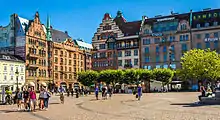 Malmö 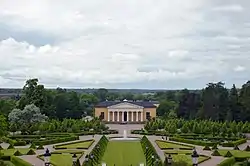 Uppsala | ||
| 1 | Stockholm | 2,308,143 | Stockholm County | Svealand | |||
| 2 | Gothenburg | 1,021,831 | Västra Götaland County | Götaland | |||
| 3 | Malmö | 669,471 | Skåne County | Götaland | |||
| 4 | Uppsala | 294,689 | Uppsala County | Svealand | |||
| 5 | Helsingborg | 242,540 | Skåne County | Götaland | |||
| 6 | Linköping | 207,052 | Östergötland County | Götaland | |||
| 7 | Örebro | 206,344 | Örebro County | Svealand | |||
| 8 | Västerås | 198,800 | Västmanland County | Svealand | |||
| 9 | Jönköping | 170,494 | Jönköping County | Götaland | |||
| 10 | Norrköping | 163,368 | Östergötland County | Götaland | |||
| Based on 2018 functional urban areas population estimates from Eurostat | |||||||
Metropolitan Stockholm
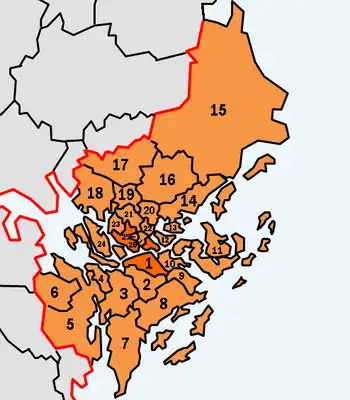
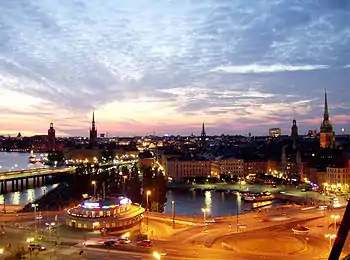
Metropolitan Stockholm (also known as Greater Stockholm or, in Swedish, Storstockholm), is a metropolitan area surrounding the Swedish capital of Stockholm. Since 2005, Metropolitan Stockholm is defined by official Swedish Statistics as all of Stockholm County.[5] It is the largest of the three metropolitan areas in Sweden.
Metropolitan Stockholm is divided into 5 areas: Stockholm City Centre, Söderort, Västerort of Stockholm Municipality; and the northern suburbs and southern suburbs, which consists of several municipalities.
| Municipality | Population | Area[1] | Density[2] | Part |
|---|---|---|---|---|
| Stockholm | 914,909 | 187.17 | 4,861.76 | Centre, West, South |
| Huddinge | 104,353 | 131.01 | 795.01 | Southern Suburbs (Södermanland) |
| Botkyrka | 89,142 | 194.17 | 451.05 | |
| Salem | 16,201 | 54.09 | 297.76 | |
| Södertälje | 92,490 | 525.15 | 175.18 | |
| Nykvarn | 9,862 | 152.76 | 63.52 | |
| Nynäshamn | 27,168 | 358.76 | 75.16 | |
| Haninge | 82,676 | 458.07 | 179.04 | |
| Tyresö | 45,629 | 69.25 | 651.94 | |
| Nacka | 96,420 | 95.12 | 1,005.61 | |
| Värmdö | 40,660 | 448.03 | 89.91 | Northern Suburbs (Uppland) |
| Lidingö | 45,598 | 30.80 | 1,476.23 | |
| Vaxholm | 11,385 | 57.88 | 195.51 | |
| Österåker | 41,317 | 312.40 | 131.33 | |
| Norrtälje | 57,694 | 2016.04 | 28.50 | |
| Vallentuna | 32,008 | 358.36 | 88.96 | |
| Sigtuna | 44,174 | 327.40 | 134.46 | |
| Upplands-Bro | 25,370 | 235.47 | 107.15 | |
| Upplands Väsby | 41,883 | 75.09 | 556.49 | |
| Täby | 67,519 | 60.72 | 1,109.24 | |
| Sollentuna | 69,525 | 52.64 | 1,314.27 | |
| Danderyd | 32,286 | 26.40 | 1,222.01 | |
| Järfälla | 71,130 | 53.81 | 1,306.11 | |
| Ekerö | 26,770 | 217.68 | 122.30 | |
| Sundbyberg | 44,663 | 8.67 | 5,047.64 | |
| Solna | 74,273 | 19.30 | 3,834.77 | |
| Total | 2,205,105 | 6,526.24 | 335.94 |
1 km2
2 Population per km2
Metropolitan Gothenburg
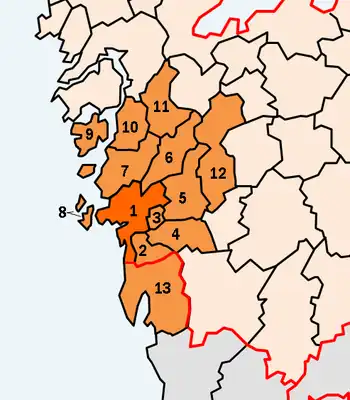

Metropolitan Gothenburg (Storgöteborg or literally Greater Gothenburg), is a metropolitan area surrounding the city of Gothenburg in Sweden. The metropolitan region is located in Västra Götaland County, except for the municipality of Kungsbacka, which is located to the south in Halland County. As of 2005, the municipalities of Alingsås and Lilla Edet were added to the region. The region is often used for statistical measures, and estimates in the 1960s predicted that the region would have about one million inhabitants in the year 2000. The region is the second largest metropolitan area in Sweden after Metropolitan Stockholm.
| Municipality | Population | Area[1] | Density[2] |
|---|---|---|---|
| Gothenburg | 565,496 | 447.76 | 1,206.30 |
| Mölndal | 66,733 | 145.84 | 430.05 |
| Partille | 37,931 | 56.83 | 641.62 |
| Härryda | 37,430 | 266.78 | 135.83 |
| Lerum | 41,660 | 258.61 | 153.50 |
| Ale | 30,399 | 316.51 | 89.54 |
| Kungälv | 44,312 | 362.59 | 116.64 |
| Öckerö | 12,930 | 25.74 | 490.09 |
| Tjörn | 15,862 | 167.36 | 90.17 |
| Stenungsund | 26,325 | 251.91 | 100.08 |
| Lilla Edet | 13,948 | 316.23 | 41.05 |
| Alingsås | 40,566 | 472.03 | 82.86 |
| Kungsbacka | 82,382 | 606.67 | 128.73 |
| Total | 1,015,974 | 3,694.86 | 262.25 |
1 km2
2 Population per km2
Metropolitan Malmö


Greater Malmö (Stormalmö), also known as Metropolitan Malmö is the metropolitan area of Malmö in Sweden. The area is located in Southwestern Scania (Sydvästra Skåne), which is often considered synonymous with Greater Malmö, and it is part of the wider transnational Öresund Region. Besides Malmö, large towns in Greater Malmö includes Lund and Trelleborg, the former of which was the seat of the historical Catholic Archdiocese of Lund.
Since the 1970s, improvements in highways and the regional and InterRegio train networks means the commuting area has grown to include Ystad, Skurup, Sjöbo, Eslöv, Höör, Landskrona and Helsingborg, though only some of these are included in official definitions of Greater Malmö. It's not uncommon to live in Malmö and work either in Ystad or Helsingborg, or vice versa, but these towns have kept their mental allegiance with older divisions of Scania. Commuting across the Öresund has become more common, both through the Øresund Bridge and the HH Ferry route, at which car ferries departs every 12 minutes in summer (every 15 minutes in winter).
Statistics Sweden, which sets the official definitions for all metropolitan areas in Sweden, has changed which municipalities are included in Greater Malmö over time. The most recent change to the definition came in 2006, when Eslöv, Höör, and Skurup Municipalities became part of Greater Malmö, bringing the number of municipalities included from 9 to 12.
| Municipality | Population[6] | Area (km2)[7] | Density (N per km2) |
|---|---|---|---|
| Malmö | 351,749 | 156.95 | 2,241.4 |
| Lund | 123,495 | 426.83 | 289.3 |
| Trelleborg | 44,992 | 340.00 | 132.3 |
| Vellinge | 36,460 | 142.65 | 255.6 |
| Eslöv | 33,667 | 418.96 | 80.4 |
| Kävlinge | 31,536 | 152.45 | 206.9 |
| Lomma | 24,782 | 55.49 | 446.6 |
| Staffanstorp | 24,778 | 106.81 | 232.0 |
| Svedala | 21,654 | 217.71 | 99.5 |
| Burlöv | 18,449 | 18.90 | 976.1 |
| Höör | 16,691 | 290.51 | 57.5 |
| Skurup | 15,731 | 193.42 | 81.3 |
| Total | 733,037 | 2,520.68 | 290.8 |
See also
References
- ↑ SCB Statistics Sweden – Definition of Metropolitan Areas in Sweden published in 2005
- ↑ SCB Statistics Sweden - Population Statistics published November 10, 2014 (only available in Swedish) Archived November 11, 2014, at the Wayback Machine
- ↑ SCB Statistics Sweden - Official Land Area per Municipality, retrieved February 24, 2014 (only available in Swedish) Archived January 18, 2014, at the Wayback Machine
- ↑ "Population on 1 January by age groups and sex - functional urban areas". 2021.
- ↑ SCB Statistics Sweden – Regional Divisions in Sweden published in 2005
- ↑ "Folkmängd i riket, län och kommuner 31 mars 2019 och befolkningsförändringar 1 januari–31 mars 2019" (in Swedish). Statistics Sweden. 2019-05-10.
- ↑ "Land and water area 1 January by region and type of area. Year 2012 - 2019". Statistics Sweden. Retrieved 2019-07-23.